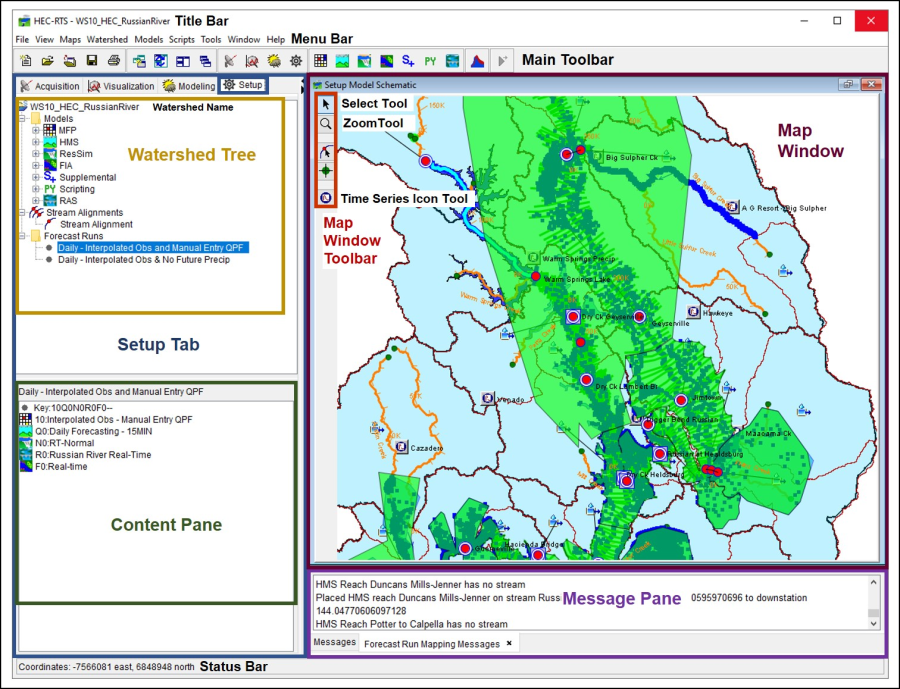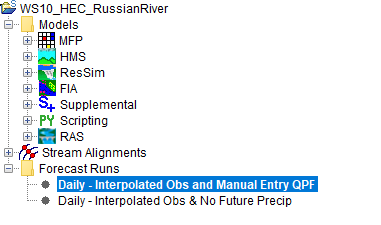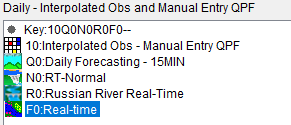Setup Module Overview
The Setup module is the grouping of commands for configuring an HEC-RTS watershed. From the HEC-RTS main window, click the Setup tab (Figure 1). A detailed discussion of common screen components is presented in HEC-RTS Interface. The Setup tab (Figure 1) displays the name of the watershed, the tree of the watershed, and the schematic of the watershed. The following sections provide an overview of the Setup module interface.

Menu Bar
The following is an overview of the Menu Bar (Figure 1) for the Setup module. The File, View, Maps, Scripts, Tools, Window, and Help menus and their commands are common to all modules and are discussed in HEC-RTS Main Window.
| Watershed | From this menu, you can view the watershed properties; view a tree of the watershed files; manage stream reach aliases; view a list of the streams in the watershed; import or export stream alignment files (refer to Stream Alignment); import a CWMS 2.1 watershed; and, team modeling. The available commands are: Watershed Properties, Files, Stream Reach Alias Editor, List of Streams, Stream Alignment (refer to Stream Alignment), Import 2.1 Watershed, and Team. |
| Models | From this menu you can review the steps of the Setup module; establish the program order; import model alternatives; specify model alternative keys; configure forecast runs; setup model linking; and, access the extract and post editors. Available commands are: Next Steps, Program Order, Import, Model Alternative Keys, Forecast Runs, Model Linking, Edit Extract, Edit Post, and commands related to models configured in the watershed (e.g., HMS). |
Map Window
The map window in the Setup module (Figure 1) displays a schematic of the watershed. Depending on where you are at in the creation of a watershed, the map window will display the current status of the watershed. From the Watershed Tree, you can also influence what is displayed in the Setup module map window. The map window tools allow the user to access and configure elements (time series icons, stream alignment, stream nodes) within your watershed. A description of the map and stream alignment tools is included in Map Window.
Watershed Tree
The Watershed Tree (Figure 2) provides a visual of the selected watershed in a tree format. At the top of the tree is the name of the watershed (WS10_HEC_Russian River). There are three main nodes (folders) to the watershed tree – Models, Stream Alignments, and Forecast Runs. You can expand (![]() ) or collapse (
) or collapse (![]() ) the folders to view further details about the selected watershed. For example, in Figure 1, the Forecast Runs folder has been expanded, which displays the available forecast runs for the watershed. Double-click on a forecast run (Daily – Interpolated Obs and Manual Entry QPF), the map window (Figure 1) will now display the schematic for the selected forecast run.
) the folders to view further details about the selected watershed. For example, in Figure 1, the Forecast Runs folder has been expanded, which displays the available forecast runs for the watershed. Double-click on a forecast run (Daily – Interpolated Obs and Manual Entry QPF), the map window (Figure 1) will now display the schematic for the selected forecast run.

Content Pane
The Content Pane (Figure 3) displays information based on selections made in the Watershed Tree. For example, in Figure 2, a forecast run (Daily – Interpolated Obs and Manual Entry QPF) has been selected. The Content Pane (Figure 3) displays information about the forecast run that includes the name of the forecast run, the key code of the forecast run, and the model alternatives that make-up the forecast run.
